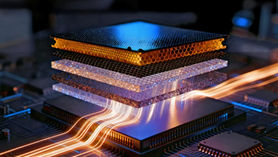Emission-free power generation Neutrinovoltaic at the implementation stage
- https://novostienergetiki.ru/
- Jul 29, 2022
- 5 min read
Updated: Sep 24, 2022
The current geopolitical situation is developing in such a way that energy supply issues have become an absolute priority for the state policy of the EU countries.Not only the countries importing energy resources turned out to be vulnerable to the prospect of reducing gas supplies from Russia, at the same time, the vulnerability of existing power generation technologies, both traditional and alternative energy, was once again proven.

Shortly before his death, the famous physicist Stephen William Hawking suggested that neutrinos are the only hope of humanity for a way out of the coming energy crisis, which threatens to forever end the history of human progress.Although neutrino radiation is not visible to the human eye, it is a potentially unlimited energy source, and scientists have taken the first steps towards using this energy source for practical purposes.
The progress made in recent years in the field of research and creation of new nanomaterials gives many scientists reason to agree with Stephen Hawking's opinion about the role of neutrinos in energy supply in the future and reasonably assume that the new era of energy will be based on the use of nanomaterials both in the field of electricity generation andand in the field of its delivery to the consumer with minimal losses.
The level of development of science and the knowledge gained make it possible to realize the predictions of Stephen Hawking right now. At least now it is considered proven that graphene is a material that allows you to convert the kinetic energy of neutrinos and other particles of the surrounding radiation fields into an electric current. Of course, this is not a unanimous opinion of the scientific community, many scientists, agreeing that graphene allows you to collect energy from the surrounding space, suggest that this property of graphene is a consequence of the exclusively thermal Brownian motion of its atoms. This opinion arose as a result of information published by a group of scientists from the University of Arkansas, led by Professor Thibado, that graphene is able to extract energy from the surrounding space.
In an interview with Research Frontiers, Professor Thibado (University of Arkansas) stated: “This is the key to using the movement of 2D materials as a source of inexhaustible energy.The tandem vibrations cause ripples in the graphene sheet, which makes it possible to extract energy from the surrounding space using the latest nanotechnology.”
However, the group led by Professor Thibado was unable to offer a practical application for this discovery, as scientists recorded an extremely weak generated power, the practical application of which is impossible. Unlike the group of Professor Thibado, the scientists of the Neutrino Energy Group, led by Holger Thorsten Schubart, directed their research to solving issues related specifically to the practical use of graphene for the needs of power generation, relegating to the background the fundamental scientific research of graphene and the mechanism of electricity generation. Experimental work was completed in 2014, i.e. long before the publications of Professor Thibado, thus providing absolute leadership in this direction.
In contrast to the opinion of Professor Thibado, the Neutrino Energy Group scientists concluded that graphene generates electricity not only due to thermal Brownian motion, but also under the influence of neutrinos and other particles of the surrounding radiation fields. This statement has found its experimental substantiation in the publications of the COHERENT collaboration at the Oak Ridge National Laboratory (USA). Low-energy neutrinos have been found to interact weakly with argon nuclei. This process is called coherent elastic neutrino-nuclear scattering (CEvNS). A neutrino, like a tennis ball hitting a bowling ball, hits the large and heavy nucleus of an atom and transfers a tiny amount of energy to it. As a result, the core almost imperceptibly bounces off, i.e. Low-energy neutrinos participate in weak interactions with matter nuclei.

Since graphene is carbon, the atomic mass of which is lighter than the atomic mass of argon, the effect of neutrino interaction with carbon nuclei is more pronounced than with argon, and leads to an increase in the amplitude of vibrations of graphene atoms (graphene waves), caused, among other things, by thermal Brownian motion. Thus, it can be argued that the energy of neutrinos that fall on 1 cm2 of the earth's surface with an intensity of 60 billion particles per second can be converted into electric current, and such a conversion should not depend on weather conditions or on the season and be a stable day and at night. The mechanism of energy transfer from low-energy neutrinos, as well as any other energies, also occurs due to coherent elastic neutrino-nuclear scattering.
Neutrino Energy Group has decided not to disclose the results of the experiments until the end of all research and laboratory studies and the receipt of a patent for the invention. Such a decision was justified by the exceptional significance of the work being carried out, as well as their commercial nature, given that the financing was carried out at the expense of own capital without state subsidies, and only stable positive results of the experiments that were obtained and made public in 2014 gradually attracted the interest of a wide range of investors .
Created by Neutrino Energy Group, the Neutrino Power Cube power source allows it to be installed directly at the place of energy consumption, which eliminates the loss of power in the power grid. Neutrino Power Cube test samples, currently developed jointly with a Swiss company, combine 7 power generating modules that generate a gross power of 7 kWh, but up to 2 kWh of generated power is used for own needs, because. The Neutrino Power Cube has several outputs with different power ratings for both DC and AC 220V and 380V, which results in power loss when the generated energy is converted by the electronics, i.e. the guaranteed net power of such a source of electricity is 5 kWh.
The geometric dimensions of the Neutrino Power Cube, which include, in addition to 7 power generating modules, also control elements along with electronics for converting the generated current, make it easy to place it inside residential premises.At the request of customers, the output power can be increased by connecting additional power generating modules.

Holger Thorsten Schubart, mathematician and president of the international holding Neutrino Energy Group, about the principle of operation of the Neutrino Power Cube: “The power generating module is a set of pressed power generating plates placed in a separate case. Such a plate is a metal foil with a multilayer nanomaterial deposited on one side of alternating layers of graphene and doped silicon. The coated side of the metal foil is the positive pole, while the uncoated side is the negative pole. The oscillations of graphene atoms under the influence of Brownian motion are amplified by the external influence of the surrounding radiation fields, including the neutrino flux, which causes a resonance of the vibrations of graphene atoms, which is removed in the form of a direct electric current. Atomic vibrations at resonance make it possible to enhance the recoil of electrons upon contact with doped silicon. Graphene is a material that converts the thermal Brownian motion of graphene atoms, as well as the kinetic energy of the particles of the surrounding radiation fields, including the neutrino flux, into an electric current.”
Commercial production of Neutrino Power Cubes power sources will begin in Switzerland under a license agreement as early as 2023, which, given the growing problems with energy supply in the EU, opens up almost limitless prospects for the Neutrinovoltaic project.





















































Comments